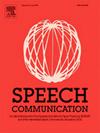Systematic review: The identification of segmental Mandarin-accented English features
IF 2.4
3区 计算机科学
Q2 ACOUSTICS
引用次数: 0
Abstract
Background
The pronunciation of L2 English by L1 Mandarin speakers is influenced by transfer effects from the phonology of Mandarin. However, there is a research gap in systematically synthesizing and reviewing segmental Mandarin-accented English features (SMAEFs) from the existing literature. An accurate and comprehensive description of SMAEFs is necessary for applied science in relevant fields.
Aim
To identify the segmental features that are most consistently described as characteristic of Mandarin-accented English in previous literature.
Methods
A systematic review was conducted. The studies were identified through searching in nine databases with eight screening criteria.
Results
The systematic review includes nineteen studies with a total of 1,873 Mandarin English speakers. The included studies yield 45 SMAEFs, classified into Vowel and Consonant categories, under which there are multiple sub-categories. The results are supported by evidence of different levels of strength. The four frequently reported findings, which are 1) variations in vowel height and frontness, 2) schwa epenthesis, 3) variations in closure duration in plosives and 4) illegal consonant deletion, were identified and analyzed in terms of their potential intelligibility outcomes.
Conclusion
The number of SMAEFs is large. These features occur in numerous traditional phonetic categories and two categories (i.e. schwa epenthesis and illegal consonant deletion) that are typically used to describe features in connected speech. The study outcomes may provide valuable insights for researchers and practitioners in the fields of English Language Teaching, phonetics, and speech recognition system development in terms of selecting the pronunciation features to focus on in teaching and research or supporting the successful identification of accented features.
求助全文
约1分钟内获得全文
求助全文
来源期刊

Speech Communication
工程技术-计算机:跨学科应用
CiteScore
6.80
自引率
6.20%
发文量
94
审稿时长
19.2 weeks
期刊介绍:
Speech Communication is an interdisciplinary journal whose primary objective is to fulfil the need for the rapid dissemination and thorough discussion of basic and applied research results.
The journal''s primary objectives are:
• to present a forum for the advancement of human and human-machine speech communication science;
• to stimulate cross-fertilization between different fields of this domain;
• to contribute towards the rapid and wide diffusion of scientifically sound contributions in this domain.
 求助内容:
求助内容: 应助结果提醒方式:
应助结果提醒方式:


